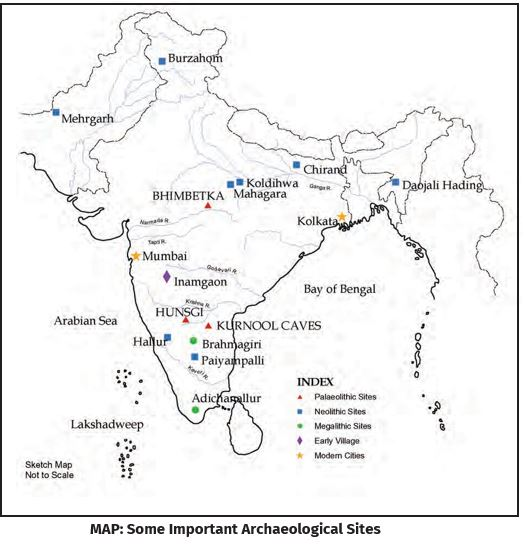Megalithic Footprints and Human Figure | 23 Nov 2024
Why in News?
Recently, 24 pairs of prehistoric Megalithic footprints and a human figure have been discovered in Madikkai, Kerala which is believed to date back to the Megalithic period.
What are the Key Highlights of Findings?
- Cultural Significance: All footprints point westward, potentially signifying their symbolic importance.
- Archaeologists interpret them as representing the souls of deceased individuals, while local residents attribute them to a goddess.
- Age: It is estimated to be over 2,000 years old, adding depth to the historical narrative of Kerala.
- Other Discoveries: It resembles prehistoric rock art found at Avalakki Pera in Udupi district, Karnataka.
- Prehistoric discoveries in Kerala include:
- Temple decorations at Erikulam valiyapara in Kasaragod.
- Running tiger carvings in Neeleswaram.
- Human figures at Cheemeni Ariyittapara.
- Bull figures at Ettukudukka in Kannur.
- Edakkal Caves carvings in Wayanad.
- Prehistoric discoveries in Kerala include:
Note
Prehistoric refers to the period of human history before the existence of written records. It encompasses the time from the earliest human existence to the advent of writing systems, which generally predates 3000 BCE.
What is Megalithic Culture?
- About: Megalithic Culture refers to a prehistoric cultural tradition characterized by the construction of large stone structures or monuments, known as megaliths.
- Chronology of Megaliths: The Brahmagiri excavation dates South India's megalithic cultures to between the 3rd century BC and 1st century AD.
- Geographical Distribution: The main concentration of megalithic culture is in Deccan, especially south of the Godavari River.
- It has been found across the Punjab Plains, Indo-Gangetic basin, Rajasthan, Gujarat, and Burzahom in Jammu and Kashmir, with key sites including Seraikala (Bihar), Khera (Uttar Pradesh), and Deosa (Rajasthan).
- Use of Iron: The Megalithic period in South India marked a full-fledged Iron Age culture, where iron technology was fully utilized.
- It is evidenced by iron weapons and agricultural implements discovered from Junapani in Vidarbha to Adichanallur in Tamil Nadu.
- Rock Paintings: Rock paintings found at megalithic sites depict scenes of hunting, cattle raids, and group dancing.
UPSC Civil Services Examination, Previous Year Question (PYQ)
Consider the following pairs: (2021)
(Historical Place) (Well-known for)
- Burzahom : Rock-cut shrines
- Chandraketugarh : Terracotta art
- Ganeshwar : Copper artefacts
Which of the pairs given above is/are correctly matched?
(a) 1 only
(b) 1 and 2
(c) 3 only
(d) 2 and 3
Ans: (d)

